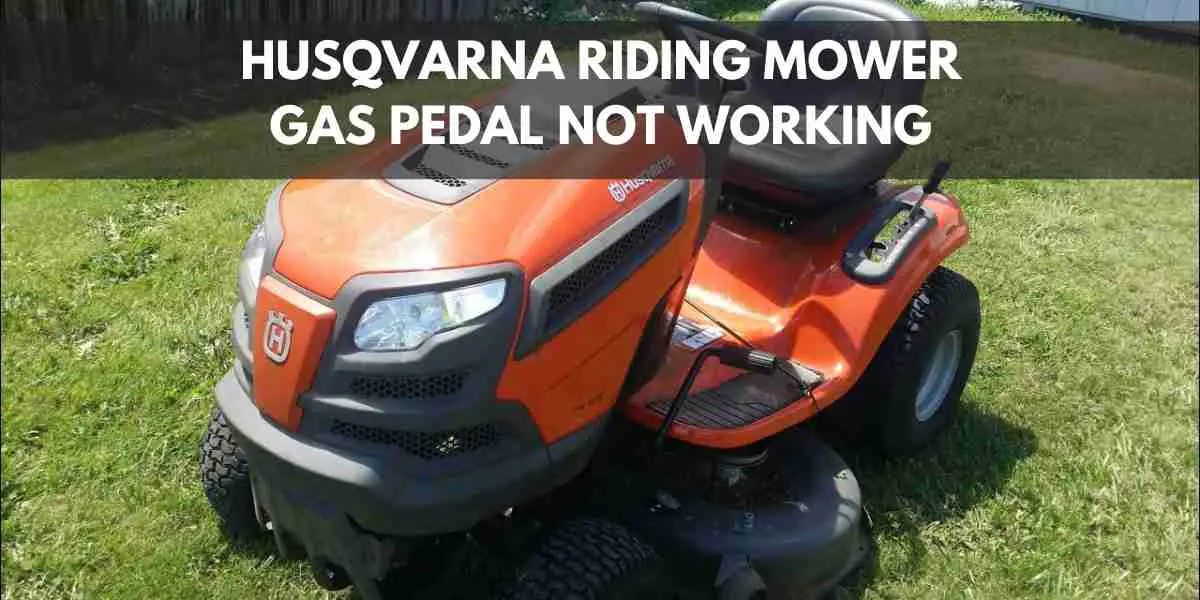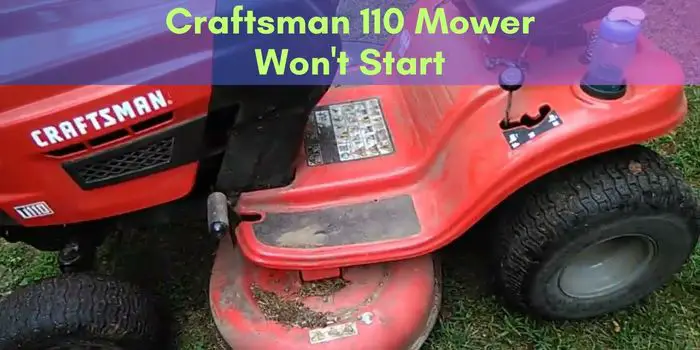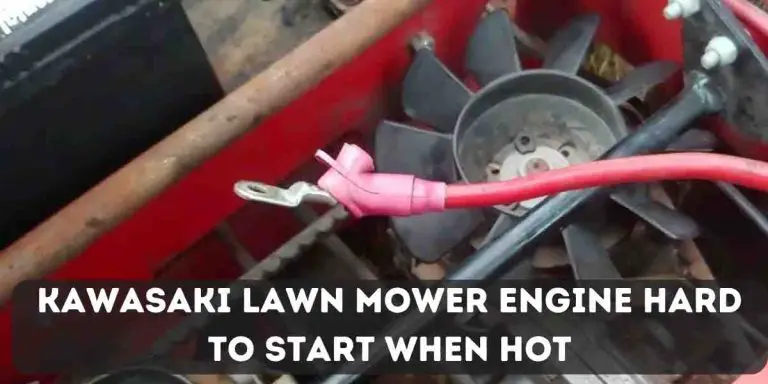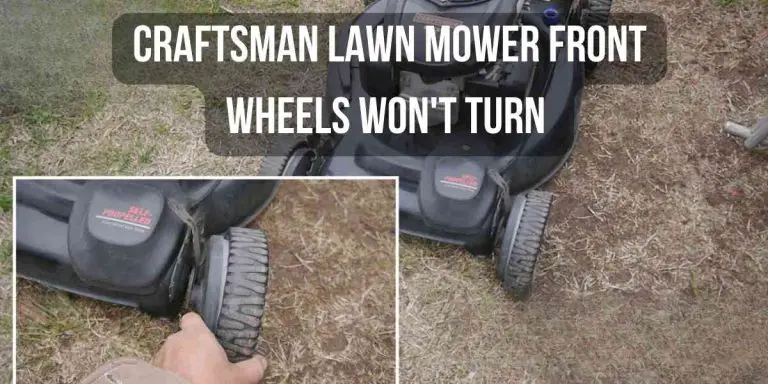Husqvarna Riding Mower Gas Pedal Not Working? Troubleshoot Now!
If your Husqvarna riding mower gas pedal is not working, there could be a few potential causes. Some common reasons for this issue include a stuck pedal, damaged belt, or faulty transmission.
It is important to diagnose the problem correctly to find an appropriate solution.
Diagnosing The Problem
Is your Husqvarna riding mower gas pedal not working? If so, there could be a few possible reasons for this issue, such as bad gas in the fuel tank, a plugged air filter, broken cooling pins, dirty carburetors, or clogged fuel lines.
It’s important to diagnose the problem accurately to determine the proper solution. Here are the initial steps to take when the gas pedal is not working:
Check for any visible damage or loose connections:
Inspect the gas pedal and its surrounding components for any signs of damage or wear. Look for loose wires or connections that may be causing the issue. It’s important to ensure that all connections are secure and in good condition.
Inspect the transmission system and other related components:
The gas pedal’s functionality depends on the transmission system and other related components. Carefully examine these parts to identify any potential problems. Make sure that the transmission is engaged properly and that there are no obstructions or debris interfering with its operation.
Examine the drive belt:
The drive belt is responsible for transferring power from the engine to the transmission system. A worn or damaged belt can prevent the gas pedal from working effectively. Inspect the belt for any signs of wear, fraying, or cracks. If you notice any issues, it may be necessary to replace the belt.
Check the pulleys:
The pulleys play a crucial role in the operation of the drive belt. They help transfer power from the engine to the transmission system. Inspect the pulleys for any signs of damage, misalignment, or excessive wear. If the pulleys are not functioning properly, it can affect the gas pedal’s performance.
Ensure proper tension on the belt:
The drive belt needs to have the correct tension to operate smoothly. If the belt is too loose or too tight, it can cause the gas pedal to stop working. Check the tension of the belt and make any necessary adjustments to ensure it is within the manufacturer’s recommended specifications.
Test the gas pedal for functionality:
Once you have inspected all the relevant components and made any necessary repairs or adjustments, it’s time to test the gas pedal. Start the engine and try depressing the gas pedal to see if it responds correctly. If the issue persists, it may be necessary to seek professional assistance to diagnose and fix the problem.
By following these steps and thoroughly inspecting the gas pedal, transmission system, drive belt, pulleys, and tension, you can diagnose the reason behind your Husqvarna riding mower’s gas pedal not working. Identifying the root cause will help you find the appropriate solution and get your mower back to optimal performance.
Remember, if you’re unsure or uncomfortable with performing the diagnosis yourself, it’s always best to consult a professional.
Common Causes And Solutions
If your Husqvarna riding mower’s gas pedal is not working, there are several common causes to consider. These include issues such as bad gas in the fuel tank, a plugged air filter, broken cooling pins, dirty carburetors, or clogged fuel lines.
Troubleshooting and fixing these problems can help get your mower back in working order.
Bad Gas In The Fuel Tank
- Bad gas in the fuel tank can have a negative impact on the performance of your Husqvarna riding mower and cause issues with the gas pedal.
- Old or contaminated gas can lead to engine sputtering, stalling, and even difficulty in starting the mower.
- To solve this problem, drain the old gas from the fuel tank using a siphon pump or by removing the fuel line.
- After draining the old gas, clean the fuel tank by wiping it with a clean cloth or using a fuel additive designed to remove contaminants.
- Finally, refill the fuel tank with fresh, clean gas to ensure optimal mower performance.
Plugged Air Filter
- A clogged or dirty air filter can restrict airflow to the engine, leading to decreased performance and unresponsiveness of the gas pedal.
- Start by locating the air filter housing on your Husqvarna riding mower. It is usually located near the engine or underneath the seat.
- Remove the air filter cover and inspect the filter. If it appears dirty or clogged, it needs to be cleaned or replaced.
- Cleaning the air filter involves gently tapping it to remove loose debris or using compressed air to blow out any trapped dirt.
- If the air filter is severely clogged, it’s best to replace it with a new one to restore your mower’s airflow and gas pedal responsiveness.
Broken Cooling Pins
- Broken cooling pins can cause overheating issues in your Husqvarna riding mower, which can, in turn, affect the gas pedal’s functionality.
- Visually inspect the cooling system of your mower, including the radiator and cooling fins, for any broken or damaged pins.
- If you spot any broken cooling pins, they will need to be replaced. You can find compatible cooling pins from Husqvarna dealers or authorized parts suppliers.
- Carefully remove the broken pins using pliers or a wrench, making sure not to damage any other components in the process.
- Install the new cooling pins securely and double-check for any signs of leakage or loose connections in the cooling system.
Dirty Carburetor
- A dirty carburetor can hinder proper fuel delivery to the engine, leading to gas pedal issues on your Husqvarna riding mower.
- Locate the carburetor on your mower, usually positioned near the engine. Refer to your owner’s manual if needed.
- Remove the carburetor cover and inspect it for any signs of dirt, debris, or residue. A clogged carburetor can contribute to poor gas pedal response.
- Clean the carburetor using a carburetor cleaner spray, following the manufacturer’s instructions. Pay close attention to the jets, throttle plate, and passages.
- After cleaning, reassemble the carburetor carefully and ensure it is properly secured before testing the gas pedal’s functionality.
Clogged Fuel Lines
- Clogged fuel lines can disrupt the proper flow of fuel to your Husqvarna riding mower’s engine, resulting in gas pedal issues.
- Start by inspecting the fuel lines, located between the fuel tank and the carburetor. Look for any visible signs of clogs, such as debris or dirt buildup.
- Clear any clogs by using compressed air or gently blowing through the fuel lines. Be cautious not to damage the lines during the process.
- If the clog persists or the fuel lines appear damaged, it may be necessary to replace them with new ones to ensure uninterrupted fuel flow.
- Once the fuel lines are clear or replaced, test the gas pedal to ensure smooth operation and proper movement of your riding mower.
Inspection And Maintenance
If your Husqvarna riding mower gas pedal is not working, it may be due to various reasons such as a faulty brake pedal, damaged belt, or clogged fuel lines. To troubleshoot the issue, you can inspect and maintain these components to ensure they are functioning properly.
Belt Inspection:
Inspecting the mower’s belts is an essential step in troubleshooting a gas pedal issue. Here’s how you can do it:
- Visually examine the belts for any signs of wear, such as cracks or fraying.
- Check for any damage or looseness in the belts that could be causing the gas pedal not to work properly.
- Replace the belts if necessary to ensure their proper functioning.
Checking The Pulleys:
The pulleys play a crucial role in the mower’s transmission system and gas pedal operation. Follow these steps to inspect and correct any issues with the pulleys:
- Inspect the pulleys for any misalignment, damage, or excessive wear.
- Look for any debris or objects that might be obstructing the pulleys’ movement.
- Correct any misalignment issues by adjusting or replacing the pulleys as needed.
Final Testing:
After troubleshooting and fixing the gas pedal issue, it’s crucial to perform a comprehensive test to ensure its proper functionality. Here’s how you can do it:
- Test the gas pedal by pressing it down and checking if the mower responds by moving forward.
- Check if the gas pedal allows you to vary the speed of the mower’s movement.
- Ensure that the gas pedal is not sticking or causing any unwanted jerking motions.
- If any issues persist, retrace your steps and double-check the belt and pulley inspections.
Remember, regular inspection and maintenance of your Husqvarna riding mower’s belts and pulleys can help prevent gas pedal issues and ensure smooth operation. By following these steps, you can troubleshoot and fix the gas pedal not working problem effectively.
Conclusion
To troubleshoot and fix a Husqvarna riding mower gas pedal that isn’t working, there are several potential causes and solutions to consider. One common issue is a power loss, which can be caused by factors such as bad gas in the fuel tank, a clogged air filter, broken cooling pins, dirty carburetors, or clogged fuel lines.
Additionally, an airlock can occur in the fuel lines when air replaces fuel, preventing the mower from starting after being refueled. Clogged or dirty air filters can also cause the mower to sputter or sound like it’s running out of gas.
Another possible cause for a mower not starting after running out of gas is dirt in the carburetor. It’s important to clean or replace any dirty components and ensure that the gas system is free of contaminants. By addressing these potential issues, you can restore the functionality of your Husqvarna riding mower’s gas pedal.






